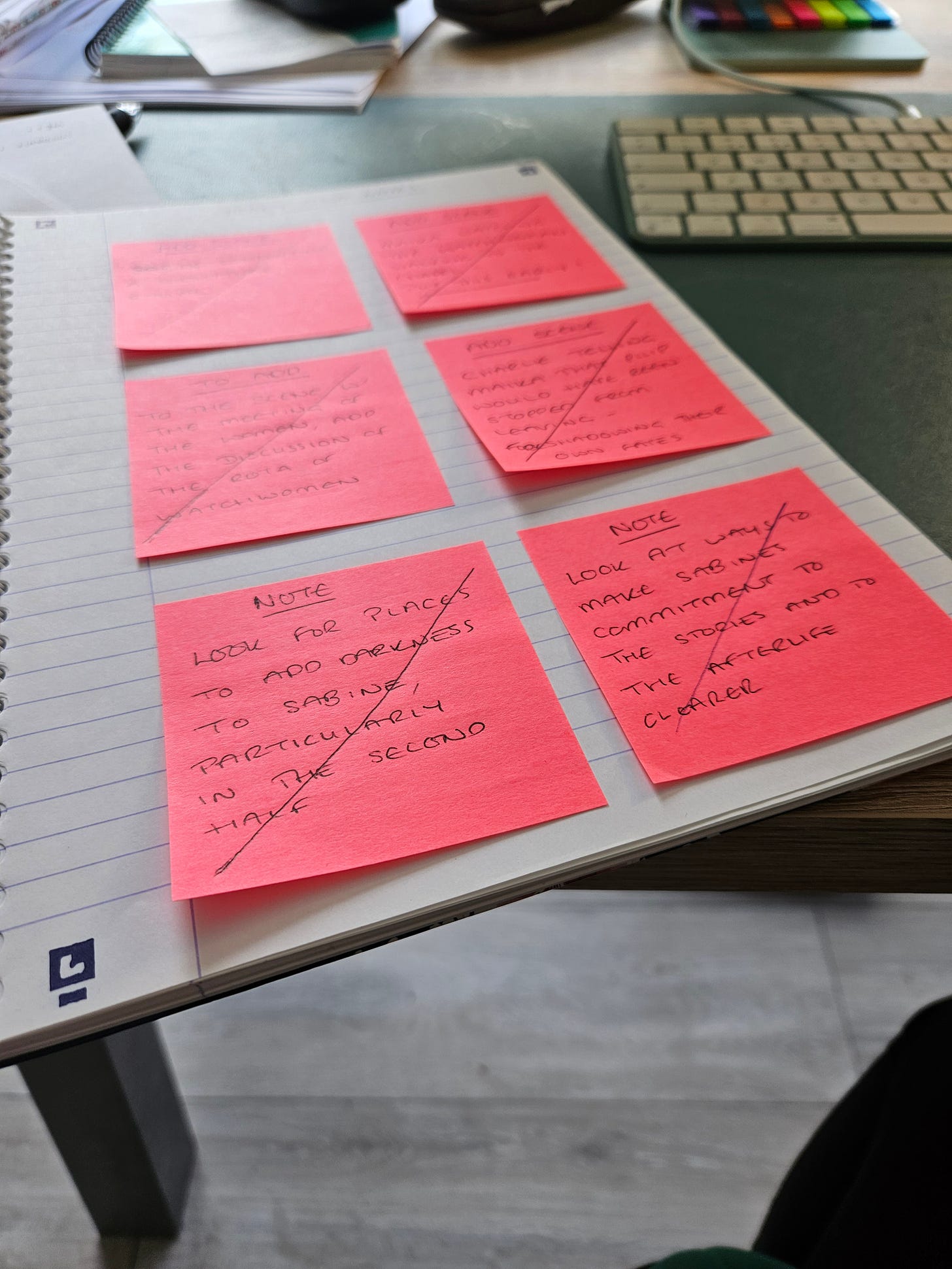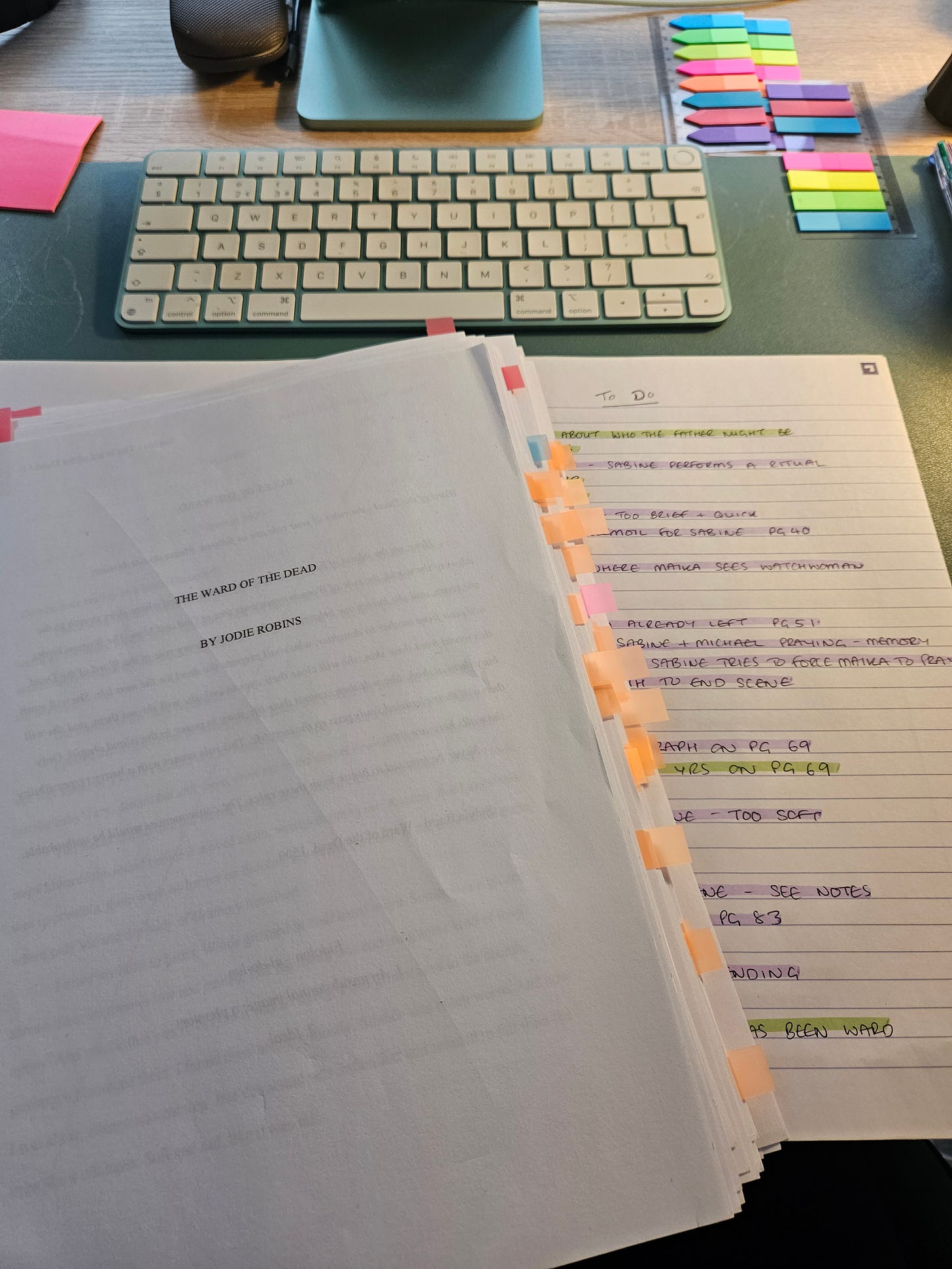Editing!
(Or get out that rag and make it shine!)
I have just reached the end of my four-month edit! Hoorah! For those who don’t know, the first draft of this book has been read by my agent and I have actioned her feedback, keeping everything crossed that I have done enough (or near enough) for it to go on submission to publishers soon.
But in the same way that plotting used to be like shooting in the dark for me, so was editing. Past me liked to make life difficult. So I have approached this edit in an entirely new way, and I wanted to share the process in the hope that it may save others (you?) from future agony. So far, this edit has been a bit of a dream - and I STILL love the story, so I’m guessing something is going right here.

Where to Start?
So you have your notes from your agent/editor/beta reader/family member/friends who decided they are editors, and you have a head full of your own thoughts - what do you do with it all?
You will need:
Your printed MS (or some other different way of reading that isn’t the same as how you wrote it)
Coloured pens
Post-it notes
Coloured sticky strip things
A note book
Your beautiful spreadsheet (for later, if you followed my plotting technique, because this is where the magic happens!)
Step One
The first thing you need to do is a read-through. This needs to be a read-through with purpose - you will be holding all the thoughts from above and applying them as you read (I usually have my notebook handy to jot down ideas as they come to me).
As I’m reading, I am:
Checking for small line edits, the tiny changes that might bring more meaning to a sentence
Looking for chapter-level structural changes
Amending dialogue to be clearer, avoiding anything ‘on the nose’
Eliminating anything that doesn't fit or slows the pace down
Ensuring there is character consistency and clear arcs for each main character, noting changes that are needed to align with the developments
Wider story arc changes such as places where a thread needs to be developed as per the feedback
Making sure the structure remains intact and the plot points all land at approximately the right time (act one turning point, midpoint, act two turning point, which I wrote more about here)
Looking for all of the above, I make scribbles directly onto my MS, I make notes of thoughts in my notebook, and, really usefully, I jot specific ideas or plans on post-its and put these in my notebook. I’m visual, and this is just a neat way of showing me the individual high-level thoughts that I need to work into the draft. I have pages that look a lot like this, and it’s wonderful when you are able to cross them out as they are addressed:
Step Two
Once the read-through is complete and you have all your notes and your thoughts gathered in your MS and your notebook, it’s time to bring it all together! This is where the spreadsheet becomes your bible. I spent a few days transferring all of my notes, both specific and higher level, into my ‘comments’ column. Not only is this useful for having everything in one place, but it allows you to go back through your thoughts, and that is where sparks can happen as you keep replaying it over in your mind.
An example of an edit note I had from Alice was to give one of my characters more of a mental decline. That’s quite broad, right? So as I was reading, I was looking for all those places I could add this, and planning where additional scenes were needed to create this arc. I did the same thing for all the other notes, too.
My comments column becomes my guide - I fill it with all the details chapter by chapter. Any new chapters are also added into the document.
And finally, as I’m transferring these ideas into my spreadsheet, I’m looking at my pages of post-its and when each is addressed/dealt with, I cross them off. Progress! It’s all about the small steps, otherwise edits can feel like a never-ending beast that has no end in sight.
Step Three
Now that I have all my thoughts gathered in my spreadsheet, it’s time to look for ways to motivate myself as I do the actual editing. Remember, up until this point, I haven’t done any ACTUAL editing, just thought gathering and thought processing.
I clear the ‘status’ column in my spreadsheet, ready for me to turn them green as I progress
I fill my printed manuscript with sticky labels that show me where line edits and chapter amendments are. Again, stripping these off as I go is really motivational!
And I list all my jobs in my notebook, complete with colour-coding so I can see what the easy to-dos are, and what will take more brain work and attention.
I had three pages of my to-do list, and of course checked off all the easy greens first. These were line edits, tiny changes etc. Purple were the slightly bigger jobs, but still fairly easy, such as adding paragraphs to what is already there, or clarifying a point being made, altering dialogue to make it work harder etc. Reds were big jobs, like chapter rewrites or entirely new chapters.
Step Four
Now you have everything you need to tackle this edit head-on, with confidence, and with the little motivational things to show you that you are making progress. Editing is hard! I find it much harder than the first draft. Shifting, moving, changing, growing parts, shrinking parts, altering characters and their arcs. Trying to hold all of that together over 80k words is really close to impossible. But it never felt too big this time around. And when I put the edit down, I knew exactly what I needed to do next. The work was hard, of course, and my brain had to work overtime to get to the crux of the feedback and how and where to apply it. But it never felt TOO hard, and that’s a big win for me!
We’ve Polished Until it Shines
Editing really is where the magic can happen, where the theme you have been searching for appears, where the character that felt flat suddenly takes centre-stage, where your dialogue becomes so of your characters you can hear them like they are in the room. It’s where threads are developed, where arcs are solidified, where the meaning of life is suddenly so clear to us! It’s tugging on a thread so hard until you thank past you for placing it there in the first place, because really you are very clever indeed. Eureka moments!
Now, I know many of you will look at this editing approach and think SOD THAT! And that’s fine. But let me tell you that all this work upfront, the processing, means the edit work itself was so much easier than any edit I have ever attempted before. In the same way that I now plot, this is all about holding everything together and not dropping any threads (something I was very bad at before). There’s still space for shifts and changes and those wonderful surprises to appear. But I felt in complete control, and that is the most important thing.
I hope there have been some nuggets here for you to use, or at least some helpful suggestions.
As always, happy writing, and especially HAPPY EDITING!



